Disclosure: This article contains affiliate links. We may earn a commission from purchases at no extra cost to you, which helps our travel content.
There's something about viewing a destination from the cockpit that gives you perspective. But Strasbourg's charms can't be fully appreciated at 30,000 feet—they must be savored at ground level, one bite at a time. As a pilot who's traversed continents, I've developed a particular fondness for regions where cultural crossroads manifest on the plate. Strasbourg's Alsatian cuisine, with its Franco-German heritage, exemplifies this beautiful culinary convergence. During a recent autumn weekend with a fellow aviation buddy, we navigated Strasbourg's cobblestone streets and timber-framed buildings in search of authentic flavors. The crisp fall air carried aromas of simmering wine, roasting meats, and freshly baked pastries through the alleys of the Old Town (Petite France). Whether you're planning a romantic getaway or simply seeking to expand your gastronomic horizons, these ten Alsatian specialties will take your taste buds on a journey more memorable than any flight plan I've ever filed.
Flammekueche: Alsace's Answer to Pizza
If Alsatian cuisine were an aircraft, flammekueche (or tarte flambée) would be its reliable workhorse—simple in design but flawless in execution. This thin-crust delight reminds me of those perfect flight plans that seem basic on paper but deliver exceptional results.
My first encounter with authentic flammekueche came at Au Brasseur, a bustling brewery-restaurant in the heart of Strasbourg's Old Town. The server arrived with what looked like an impossibly thin rectangular pizza, its edges perfectly crisp from the wood-fired oven. The traditional topping—crème fraîche, thinly sliced onions, and lardons (smoky bacon pieces)—created a harmony of flavors that was both rustic and refined.
What makes flammekueche special is its balance: the crème fraîche provides a tangy foundation, the onions add sweetness, and the lardons contribute that unmistakable savory depth. It's traditionally enjoyed with a glass of crisp Alsatian white wine or local beer.
During my weekend exploration, I discovered variations ranging from mushroom and Munster cheese to a sweeter version with apples and cinnamon. Each restaurant seems to have its own subtle approach to this regional classic, making flammekueche-hopping a delightful adventure in itself.
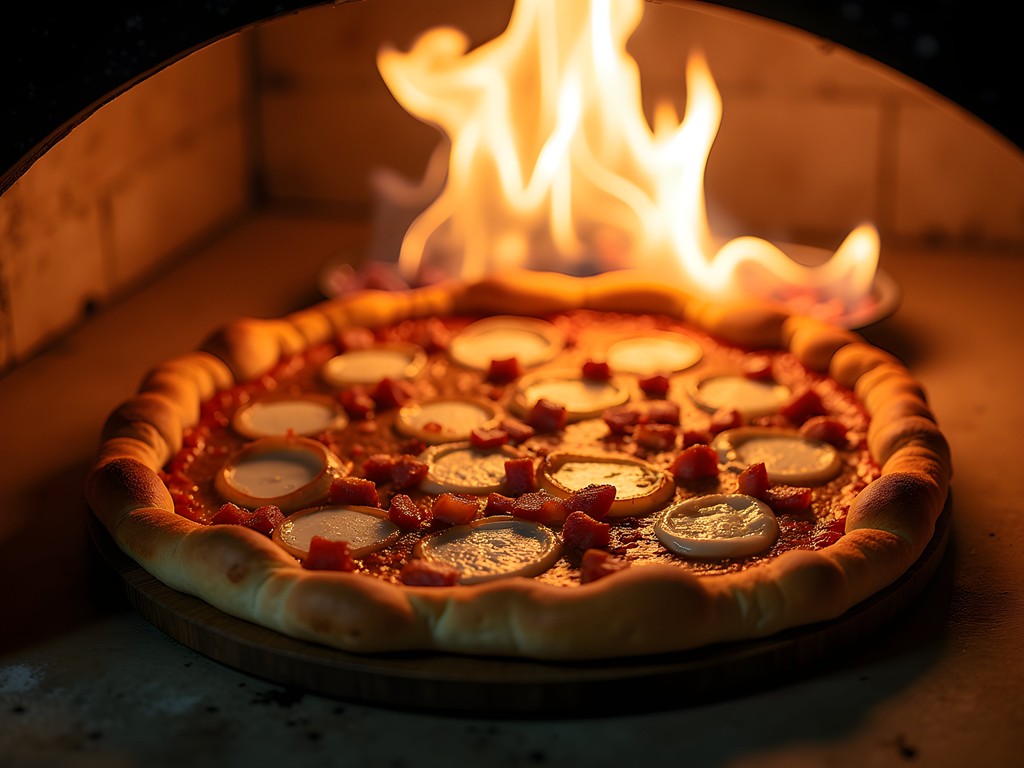
💡 Pro Tips
- For the most authentic experience, look for restaurants using wood-fired ovens
- Flammekueche is meant to be shared—order several varieties for the table
- The edges should be crispy while the center remains slightly soft—if it's soggy throughout, keep searching
Choucroute Garnie: A Symphony of Sauerkraut and Meats
If there's one dish that embodies Alsace's German influence, it's choucroute garnie. This hearty masterpiece reminds me of those long-haul flights where preparation and attention to detail make all the difference.
At Maison Kammerzell, a 15th-century building near the cathedral, I experienced what locals assured me was the quintessential choucroute. The foundation—fermented cabbage simmered in Riesling wine—arrived steaming hot, crowned with an impressive array of meats: smoked pork belly, various sausages, ham hock, and potatoes. The presentation was nothing short of spectacular, like a well-orchestrated approach into a challenging airport.
What struck me most was how the fermented cabbage balanced the rich meats. The sauerkraut isn't merely a side dish here—it's the star that ties everything together, infused with juniper berries, cloves, and bay leaves. Each bite revealed layers of flavor that spoke to the dish's long history in the region.
For optimal enjoyment, I recommend bringing your pocket knife to tackle the variety of meats with precision. This classic French folding knife has become my essential travel companion for impromptu picnics and elaborate meals alike—its carbon steel blade making short work of even the heartiest charcuterie.
Choucroute garnie isn't just food; it's a cultural statement about Alsace's ability to transform humble ingredients into something magnificent. It's best enjoyed on a cool autumn evening when its warming properties can be fully appreciated.
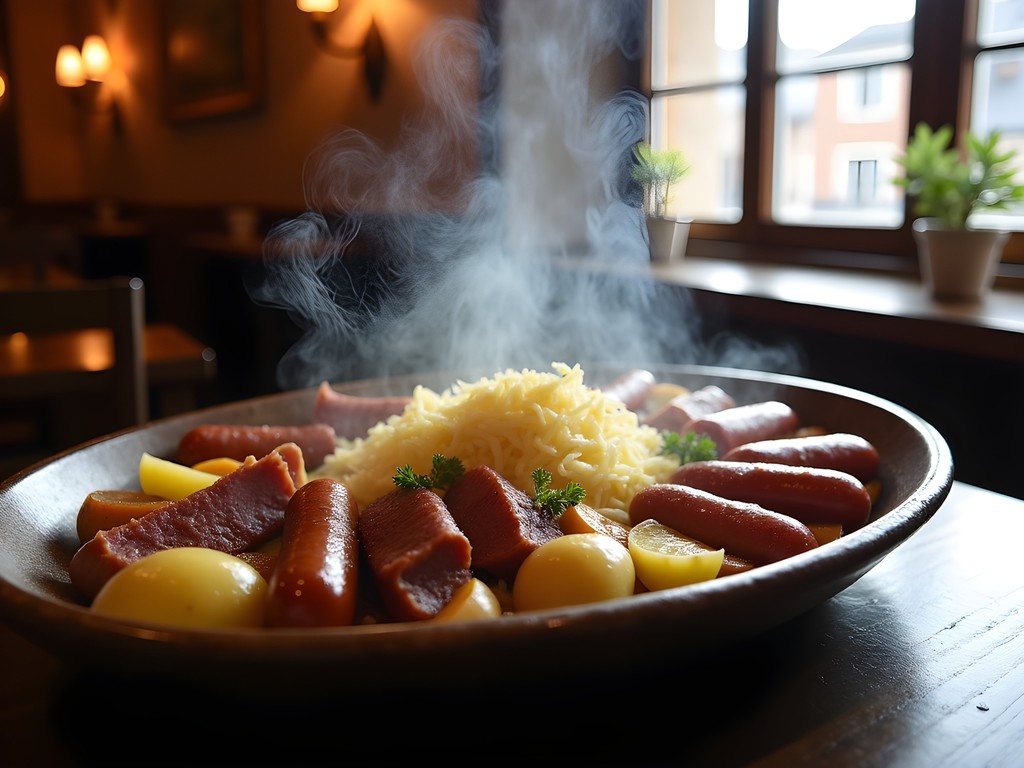
💡 Pro Tips
- Come hungry—portions are typically enormous
- Pair with local Alsatian beer rather than wine for this particular dish
- Ask for mustard on the side—the local varieties add another dimension to the flavors
Baeckeoffe: The Slow-Cooked Masterpiece
Every pilot understands the value of patience—whether waiting out weather patterns or perfecting approach timing. Baeckeoffe embodies this virtue in culinary form, a dish that refuses to be rushed and rewards those who respect its process.
The name translates to "baker's oven," referencing its traditional preparation: housewives would prepare the dish at home, then bring it to the local bakery where it would slow-cook in residual oven heat while they attended to other matters. Today, at Restaurant Le Baeckeoffe d'Alsace, I watched as our server ceremoniously broke the bread seal on our earthenware casserole, releasing an aromatic cloud that announced the dish's arrival.
Inside was a perfectly harmonized stew of marinated meats (typically pork, beef, and lamb), potatoes, onions, and carrots. The marinade—Alsatian white wine, herbs, and spices—had transformed ordinary ingredients into something extraordinary after hours of slow cooking. The meat fell apart at the touch of my fork, while the potatoes had absorbed the rich, wine-infused broth.
What makes baeckeoffe special is its representation of Alsatian pragmatism and resourcefulness. Historically, it was prepared on laundry day when women needed a meal that could cook unattended. Yet from this practical origin came one of the region's most celebrated culinary treasures.
I've found that capturing these food experiences requires proper equipment. My travel camera has become indispensable for food photography, its adjustable aperture allowing me to create those beautiful bokeh effects that make dishes like baeckeoffe look as tantalizing in photos as they taste in person.
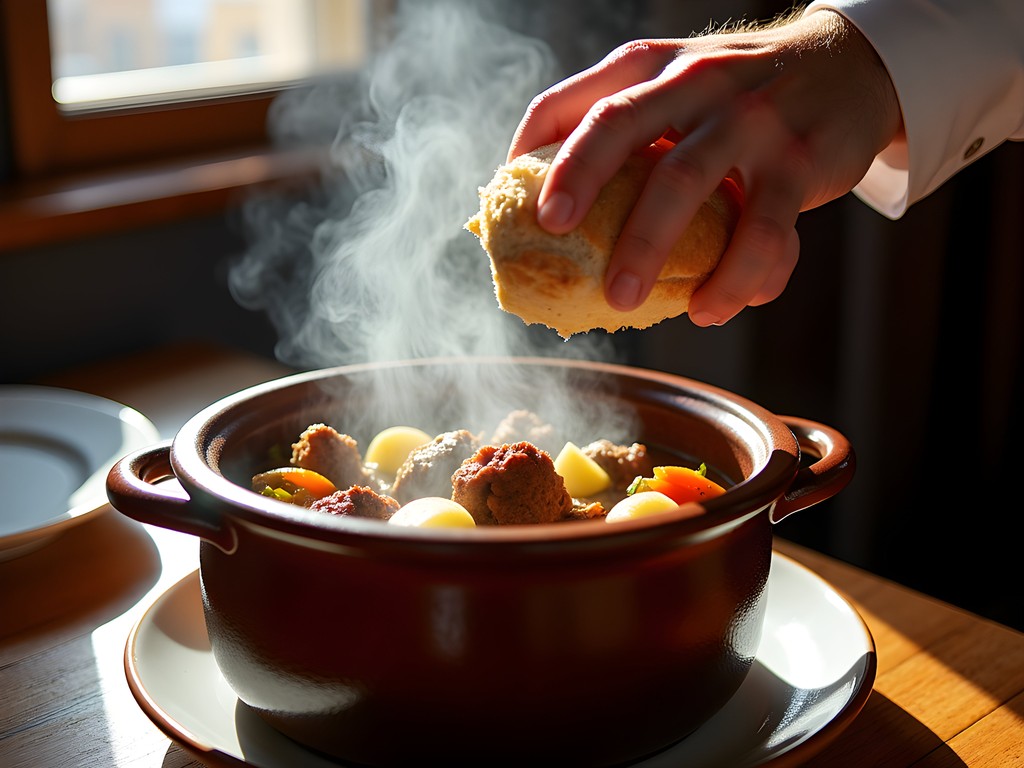
💡 Pro Tips
- Order baeckeoffe at least a day in advance at most traditional restaurants
- Look for the earthenware casserole sealed with bread dough—this is the authentic preparation
- Save room for this dish—it's substantial and meant to be the centerpiece of your meal
Kugelhopf: The Crown Jewel of Alsatian Pastries
Every successful journey needs moments of elevation, and in Strasbourg, the kugelhopf provides just that—a pastry that rises to the occasion much like an aircraft gaining perfect altitude.
At Pâtisserie Christian, tucked away on a narrow street near Strasbourg Cathedral, I discovered what locals insisted was the city's finest kugelhopf. This brioche-like cake, baked in a distinctive ring mold with a crown-like top, has a fascinating history that spans centuries. Legend has it that the Three Kings who visited Jesus brought the recipe to Alsace—though historians might dispute this charming tale.
What's undeniable is the kugelhopf's delightful texture—lighter than bread but more substantial than cake. The classic version contains raisins soaked in kirsch (cherry brandy) and almonds, with a dusting of powdered sugar creating a snow-capped appearance. The first bite reveals a subtle sweetness and buttery richness that pairs perfectly with morning coffee.
I've learned to distinguish between tourist-trap versions and authentic kugelhopf. The real deal has a moist interior with a slight resistance when pulled apart, never dry or crumbly. Some bakeries offer variations with chocolate chips or candied fruits, but purists insist on the traditional recipe.
My morning ritual in Strasbourg quickly evolved to include kugelhopf from different bakeries, comparing subtle variations like a wine connoisseur might detect terroir differences. By trip's end, I was convinced this humble pastry deserves its status as Alsace's most beloved breakfast treat.
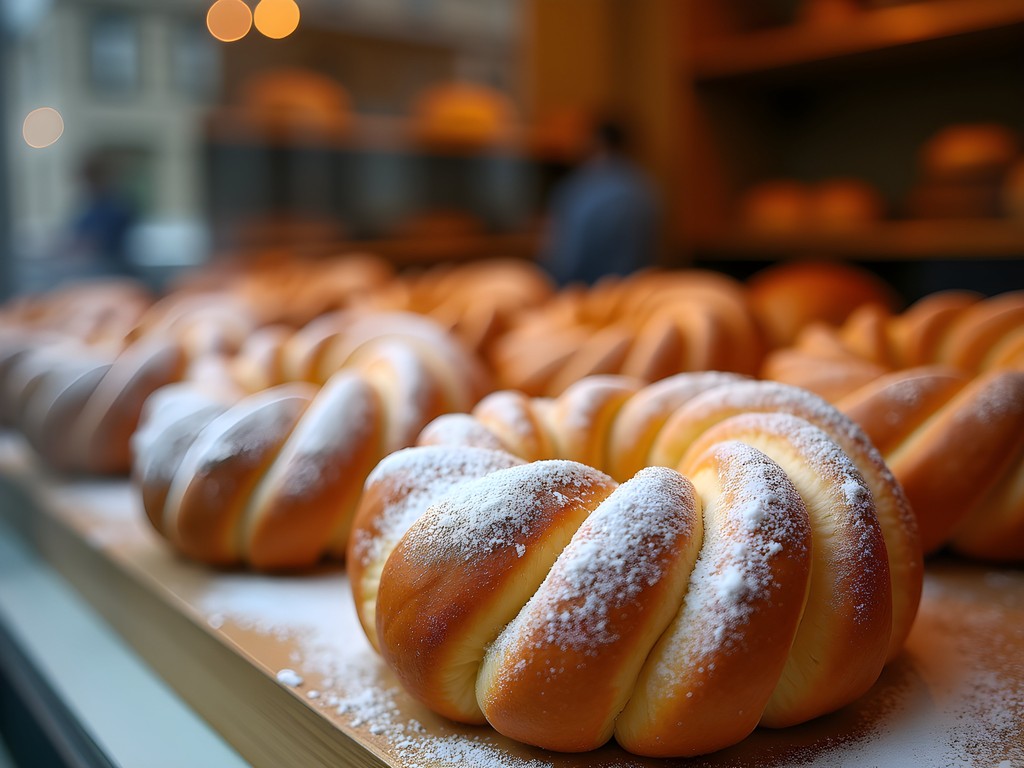
💡 Pro Tips
- Visit bakeries in the morning for the freshest kugelhopf
- Look for a golden-brown exterior with visible almonds on top
- Try both the sweet breakfast version and the savory lunch variant with bacon and walnuts
Munster Cheese: Alsace's Aromatic Ambassador
In my years as a pilot, I've learned that sometimes the most powerful experiences come in small packages—like the approach into a tiny island airport or, in this case, a wheel of Munster cheese that commands attention far beyond its size.
At La Cloche à Fromage, a cheese shop and restaurant that boasts over 100 varieties, I received my education in authentic Munster. This soft cow's milk cheese, created by Benedictine monks in the 7th century, is washed repeatedly during aging with brine and local eau-de-vie, developing its characteristic orange rind and potent aroma.
Let me be direct: Munster is not for the faint of heart. Its pungent smell belies a complex, creamy interior with flavors that range from earthy to slightly sweet. The contrast between nose and palate reminds me of those destinations that challenge your preconceptions—intimidating at first approach but revealing unexpected delights once you commit.
The traditional way to enjoy Munster is with cumin seeds, boiled potatoes, and a glass of Gewürztraminer wine. This pairing creates a perfect harmony, with the wine's aromatic profile standing up to the cheese's boldness while the potatoes provide a neutral canvas.
For those looking to bring this experience home, I've found my insulated lunch bag invaluable for transporting cheese purchases. Its insulated neoprene construction keeps cheese at the ideal temperature during day trips, and more importantly, contains those powerful aromas that might otherwise overwhelm your luggage.
A visit to a local farm in the nearby Vosges Mountains showed me the traditional production methods still used today—a reminder that some processes simply can't be improved upon by modern technology.
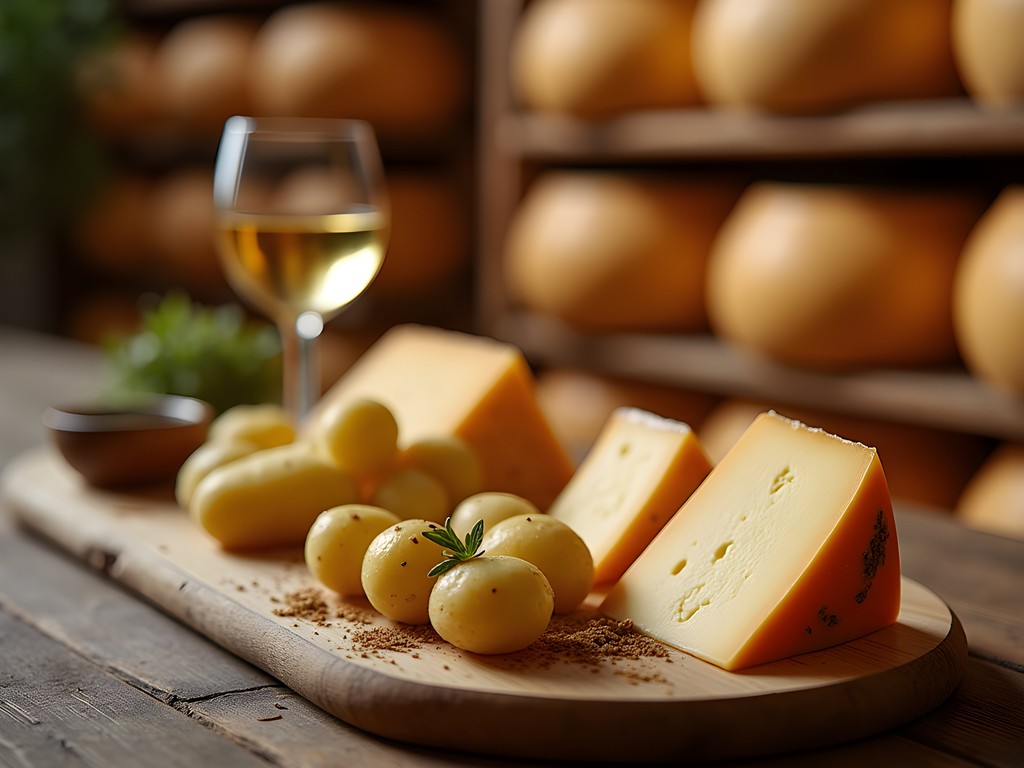
💡 Pro Tips
- Visit La Cloche à Fromage for a guided tasting experience before committing to a full wheel
- If bringing Munster home, ask the shop to vacuum seal it properly
- For the full experience, pair with local Gewürztraminer wine from the Alsace wine route
Coq au Riesling: The Elegant Cousin of Coq au Vin
Just as every region adapts aircraft for their specific conditions, Alsace has adapted classic French cuisine to showcase its local treasures. Nowhere is this more evident than in coq au Riesling—Alsace's elegant reinterpretation of the famous coq au vin.
At Winstub S'Burjerstuewel, a traditional Alsatian tavern with low wooden beams and checkered tablecloths, I discovered this regional specialty that substitutes Burgundy red wine with local Riesling. The result is a lighter, more delicate dish that maintains all the comfort of the original.
The chicken, marinated overnight in Riesling wine, is slowly braised with mushrooms, pearl onions, and bacon. The sauce—creamy white rather than rich red—carries hints of the wine's floral and mineral notes. What impressed me most was how the dish reflected Alsace itself: French technique with German influences, creating something uniquely Alsatian.
The proprietor explained that coq au Riesling emerged from the region's winemaking tradition, where no part of the harvest went to waste. Wines unsuitable for selling would be repurposed in the kitchen, transforming humble ingredients into memorable meals.
I've found that dishes like this, which tell the story of a region through flavor, deserve to be remembered in detail. My travel journal has become an invaluable companion for recording these culinary discoveries—the leather-bound pages preserving tasting notes, restaurant recommendations, and recipe ideas that I might otherwise forget in the whirlwind of travel.
The server suggested pairing the dish with—unsurprisingly—a glass of local Riesling, creating a harmonious echo between plate and glass that elevated both components. It's a reminder that sometimes the best pairings are the most straightforward ones.
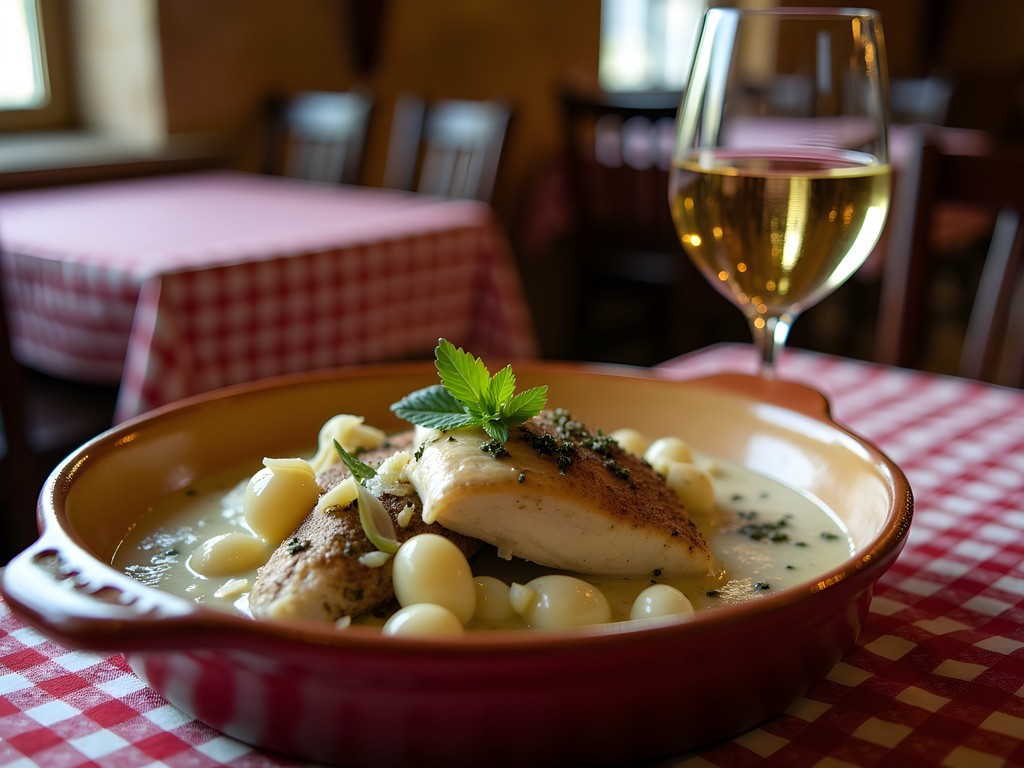
💡 Pro Tips
- Order this dish in winstubs (traditional Alsatian taverns) rather than touristy restaurants
- Look for a creamy sauce with visible mushrooms and pearl onions
- Ask about the specific Riesling used in preparation—then order a glass of the same for perfect pairing
Bretzel: Not Your Average Pretzel
Every culture has its daily bread, but few have elevated it to an art form like Alsace has with the bretzel. Unlike its American cousin, the soft pretzel, the Alsatian bretzel offers a textural masterpiece that reminds me of those perfect flight days—crisp on the outside, soft within.
Wandering through Strasbourg's Old Town, it's impossible to miss the enticing aroma emanating from bakeries like Au Bretzel d'Or, where these twisted creations are displayed proudly in windows. The classic version features a dark, shiny exterior achieved through a lye bath before baking, sprinkled generously with coarse salt crystals that catch the light like tiny diamonds.
What distinguishes an authentic Alsatian bretzel is its texture—the exterior should provide satisfying resistance before giving way to a soft, airy interior. While the traditional salted version remains the gold standard, I discovered numerous creative variations during my explorations: some topped with seeds or cheese, others incorporating bacon or onions for a more substantial snack.
Locals taught me that bretzels aren't merely street food but an integral part of Alsatian beer culture. At traditional winstubs (wine rooms that now serve beer as well), bretzels arrive automatically when you order a local brew—the saltiness perfectly complementing the beer's bitterness in a timeless pairing.
I found myself developing a morning ritual of coffee and a fresh bretzel from different bakeries, comparing subtle differences in technique and tradition. By trip's end, I could distinguish between a merely good bretzel and a truly exceptional one—a skill as satisfying as mastering a challenging landing approach.

💡 Pro Tips
- Look for bretzels with a glossy, dark brown exterior—this indicates proper lye treatment
- Try both sweet and savory variations to appreciate the bretzel's versatility
- Visit bakeries early in the morning for the freshest specimens
Spätzle: The Ultimate Comfort Side Dish
Every cuisine has its comfort foods—those dishes that ground you after a long journey. In Alsace, spätzle serves this purpose perfectly, a humble egg pasta that appears alongside many regional specialties.
At Restaurant Au Coin des Pucelles, I watched in fascination as the chef demonstrated traditional spätzle-making. The technique involves forcing a thick, egg-rich batter through a special press directly into boiling water, creating irregularly shaped noodles that capture sauce beautifully. It's a process that requires precision timing—much like coordinating descent and approach speeds.
The resulting pasta has a distinctive texture unlike any other: slightly chewy with a tender bite that commercial versions simply can't replicate. In its most basic form, spätzle is tossed with butter and herbs, but more elaborate preparations incorporate cheese (käsespätzle), caramelized onions, or mushrooms.
What makes spätzle special is its chameleon-like ability to complement nearly any Alsatian main course. It absorbs the flavors of rich meat juices from baeckeoffe, provides textural contrast to choucroute, and stands up admirably to game dishes popular in autumn.
The restaurant owner explained that spätzle represents the perfect marriage of French and German culinary traditions—the French appreciation for eggs and butter meeting German practicality and heartiness. Each family guards their specific recipe, with subtle variations in egg-to-flour ratios creating signature textures passed through generations.
After several encounters with this versatile side dish, I found myself wondering why it hasn't gained more international recognition. Perhaps some culinary treasures are best enjoyed in their native habitat, where tradition and technique combine to create something greater than the sum of simple ingredients.
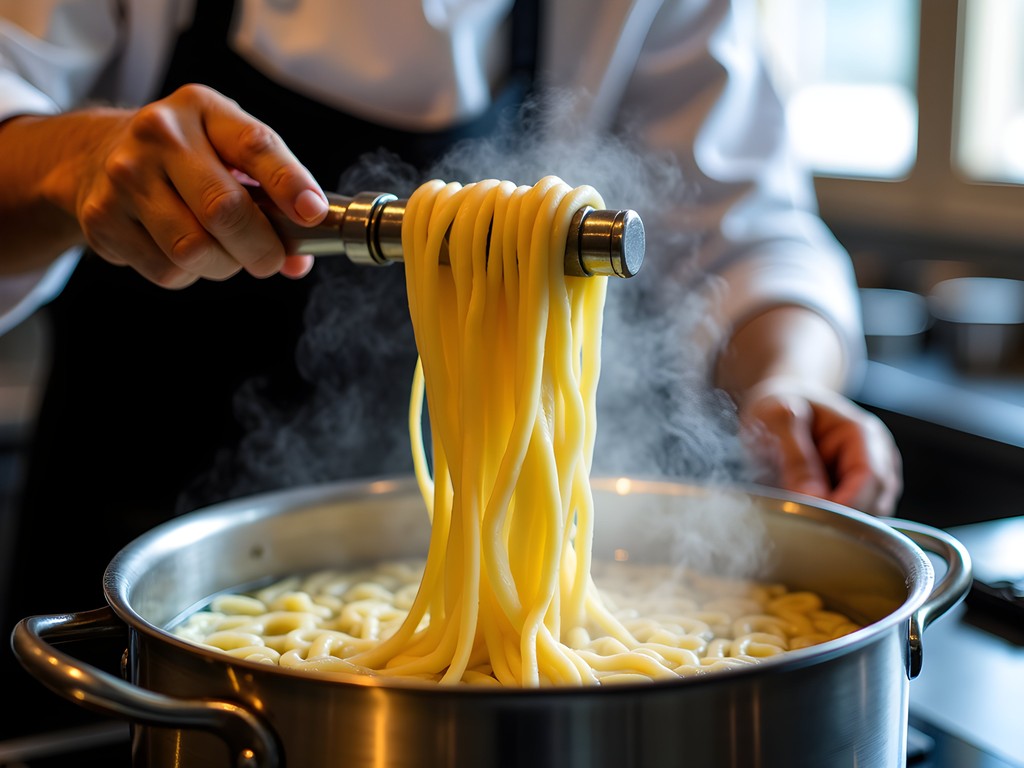
💡 Pro Tips
- Look for restaurants where spätzle is made fresh in-house rather than purchased
- Try käsespätzle (with Gruyère cheese) for a more indulgent experience
- Spätzle should have irregular shapes—perfectly uniform noodles indicate commercial production
Pain d'Épices: Strasbourg's Spiced Treasure
In aviation, we have a saying: "The journey matters as much as the destination." The same philosophy applies to Strasbourg's pain d'épices (spiced bread), whose complex flavors develop over time, rewarding those patient enough to appreciate its nuances.
At Mireille Oster's specialized shop near the cathedral, I discovered the true art of Alsatian gingerbread. Unlike the crisp cookies familiar to Americans, this pain d'épices is a dense, moist loaf infused with honey and an array of spices that speaks to Strasbourg's historical position as a trading crossroads. Cinnamon, nutmeg, cloves, anise, and ginger combine in recipes that have remained largely unchanged for centuries.
What fascinated me was learning about the Guild of Gingerbread Makers that once controlled production in Strasbourg, with strict regulations ensuring quality and protecting traditional methods. Today, artisans like Mireille Oster maintain these standards while introducing subtle innovations—I sampled varieties incorporating orange zest, chocolate, or dried fruits that complemented the spice blend perfectly.
The traditional way to enjoy pain d'épices is with a spread of butter and perhaps a touch of jam, accompanied by tea or coffee. During my visit, I discovered it also pairs wonderfully with foie gras—the bread's sweetness and spice creating a remarkable counterpoint to the rich liver.
I couldn't resist purchasing several varieties to bring home, carefully wrapped in the shop's distinctive packaging. For anyone looking to transport culinary souvenirs, I've found my packing cubes invaluable for organizing and protecting food items in luggage. These lightweight, water-resistant cubes keep fragrant items like pain d'épices from imparting their aroma to everything else in your suitcase.
The legacy of pain d'épices in Strasbourg runs deep—during the Christmas market season, elaborate decorative versions become works of art that celebrate the city's heritage and craftsmanship.
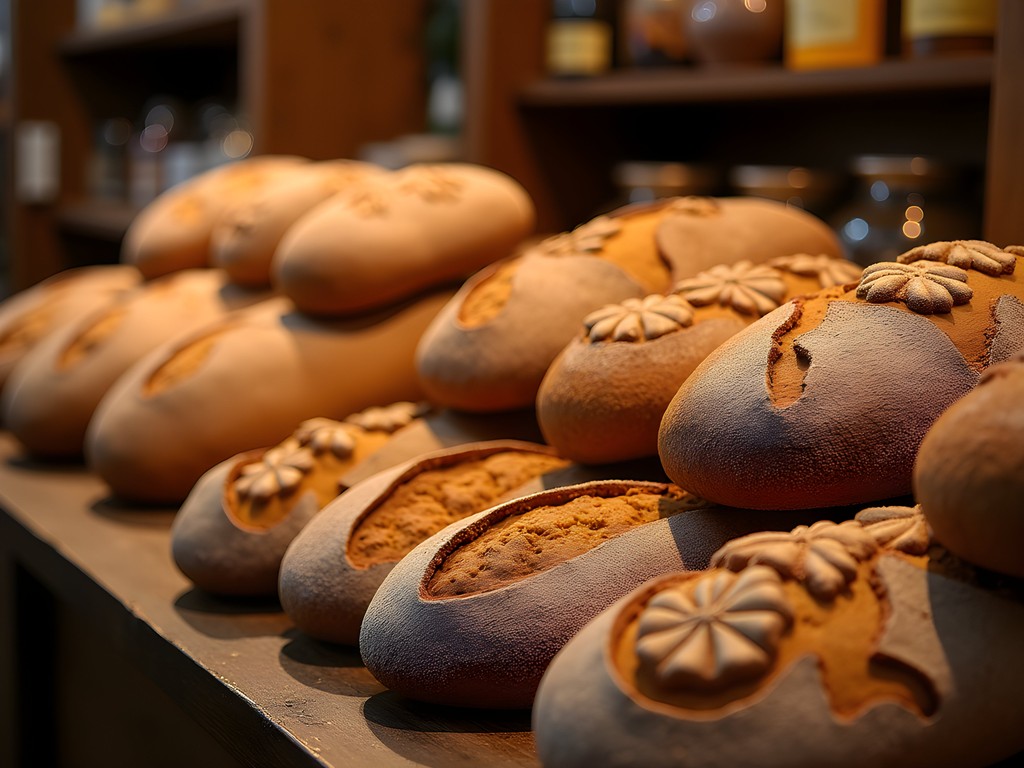
💡 Pro Tips
- Visit specialized shops like Mireille Oster rather than settling for supermarket versions
- Pain d'épices improves with age—buy it early in your trip and enjoy it throughout your stay
- Try the classic honey version before exploring more creative flavors
Vin Chaud d'Alsace: Mulled Wine with Regional Character
Every culture has its way of warming body and spirit during cooler months. In Strasbourg, particularly as autumn deepens toward winter, vin chaud d'Alsace (Alsatian mulled wine) emerges as the perfect atmospheric fuel—much like how different aircraft require specific fuel formulations for optimal performance.
At Place Kléber, where the evening air carried the first hints of the coming winter, I discovered that Alsatian mulled wine differs subtly but significantly from versions found elsewhere in France. While the base remains red wine gently heated with sugar, the spice profile reflects Strasbourg's position at the crossroads of culinary traditions.
The vendor at Christkindelsmärik (Strasbourg's famous Christmas market, which begins in late November) explained that the traditional Alsatian preparation incorporates star anise, cinnamon sticks, cloves, and orange slices—but with the addition of local eau-de-vie for extra warmth and regional character. Some vendors closely guard their spice blends like pilots protect their preferred flight routes—each claiming theirs offers the optimal experience.
What makes this beverage special is its ability to transform an ordinary evening stroll into something magical. Clutching a steaming mug of vin chaud while wandering through Strasbourg's illuminated streets creates a sensory experience that connects you to centuries of tradition.
I noticed locals and visitors alike gathering around mulled wine stands, the shared ritual creating temporary communities united by appreciation for this simple pleasure. Conversations flowed more easily, strangers exchanged recommendations, and the usual barriers between travelers dissolved in the aromatic steam rising from our cups.
While technically available year-round, vin chaud reaches its apotheosis during the pre-Christmas period when Strasbourg transforms into a wonderland of lights and decorations. Even in autumn, however, many cafés and wine bars offer their version—each with subtle variations that make comparison tasting a delightful evening activity.
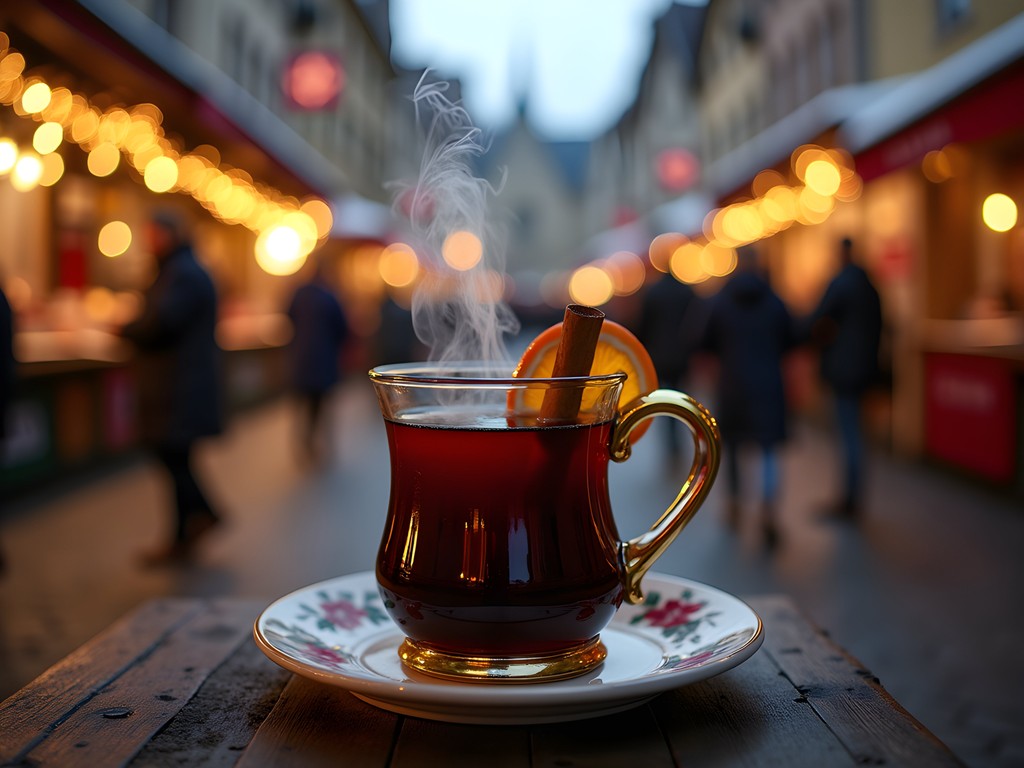
💡 Pro Tips
- Look for vendors who prepare vin chaud fresh rather than reheating from a large batch
- Pay attention to the cup—traditional ceramic mugs retain heat better than disposable options
- Don't rush the experience—vin chaud is meant to be sipped slowly while taking in your surroundings
Final Thoughts
As our weekend in Strasbourg drew to a close, I found myself reflecting on how these ten Alsatian specialties had mapped the region's cultural coordinates more precisely than any flight chart could. From the German-influenced heartiness of choucroute to the French refinement of pain d'épices, each dish told the story of this unique border region where culinary traditions have converged and evolved over centuries. What makes Strasbourg's food scene truly special isn't just the quality of individual dishes but how they collectively create a sense of place—a gastronomic landscape as distinctive as the city's architecture. Whether you're planning a romantic weekend or simply seeking new flavors, approach these Alsatian classics with an open mind and hungry heart. Like the most memorable flights, the best culinary journeys combine careful planning with spontaneous discovery. So raise a glass of Riesling to Strasbourg—a city that proves some of life's greatest pleasures are found not at 30,000 feet, but at a well-set table in a centuries-old winstub.
✨ Key Takeaways
- Strasbourg's cuisine represents a unique fusion of French and German culinary traditions
- Fall is the ideal time to visit, when seasonal ingredients enhance traditional dishes
- Look beyond tourist restaurants to winstubs (traditional Alsatian taverns) for authentic experiences
📋 Practical Information
Best Time to Visit
Fall (September-November)
Budget Estimate
$75-150 per day for food and drink
Recommended Duration
Weekend (2-3 days)
Difficulty Level
Beginner

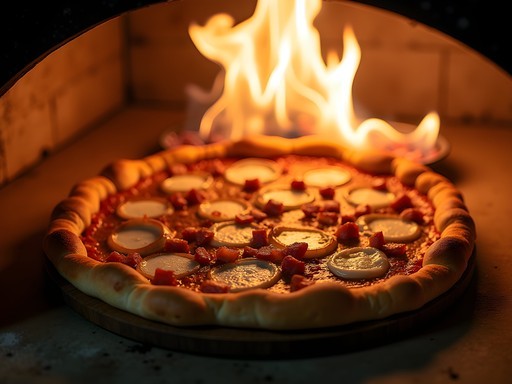
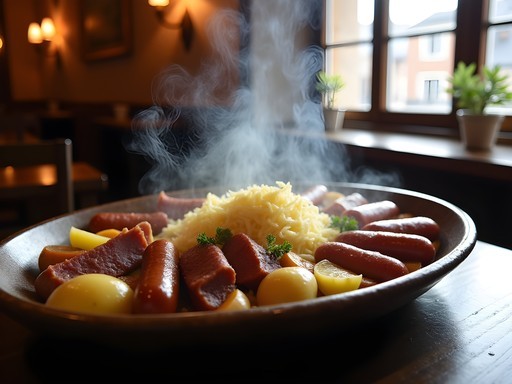
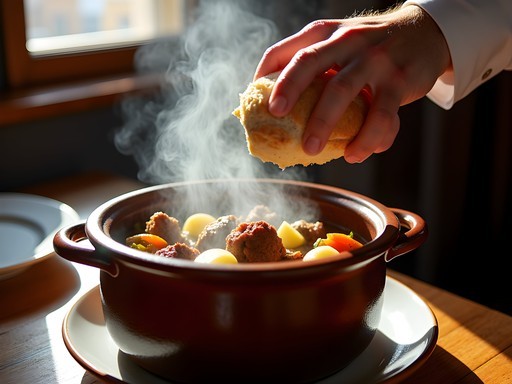
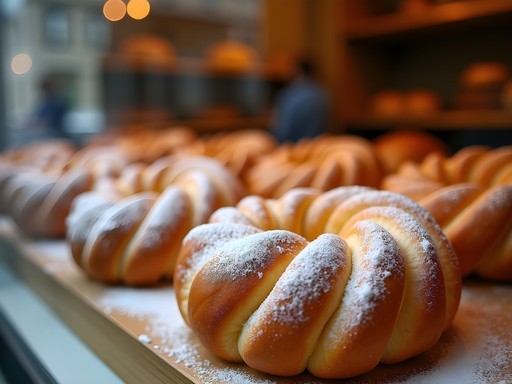

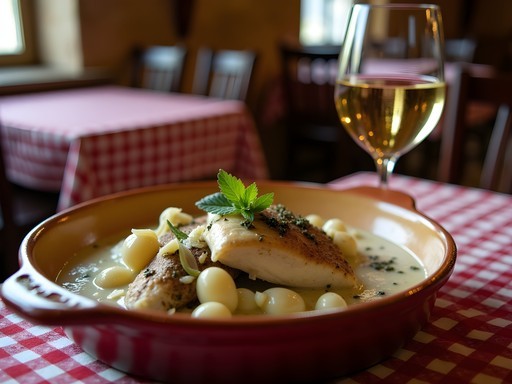




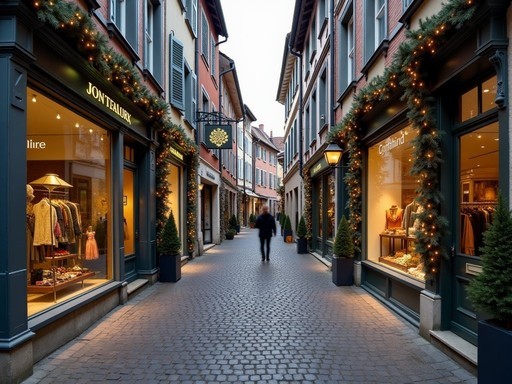




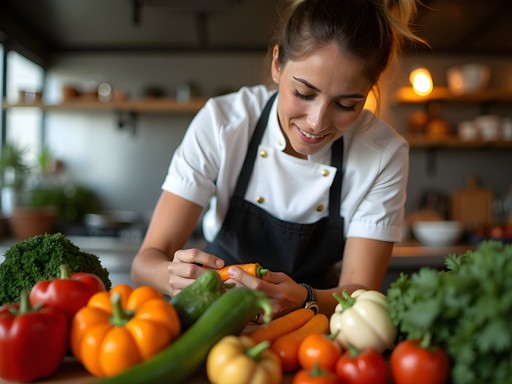
Comments
dreamguide
That Choucroute Garnie is the real deal. Had it 3 times during my week in Strasbourg!
skyway269
Just got back from Strasbourg and can confirm everything in this post! We found this amazing little place called La Cuiller à Pot that wasn't in any guidebooks. The owner speaks minimal English but makes the best Coq au Riesling I've ever had. It's on a tiny side street near the cathedral. Cash only and no reservations, but so worth it!
escapeninja
Great post! I'm planning to visit Strasbourg in November - is that a good time for these dishes? Also, are there any food festivals worth planning around?
Robert Rice
November is perfect for Alsatian cuisine! The hearty dishes like Baeckeoffe and Choucroute are ideal for cooler weather. And you're in luck - the Strasbourg Gourmet Week usually happens in November, with special menus at many restaurants. The Christmas markets also start in late November with tons of food stalls!
Casey Andersson
Robert, your post brought back such wonderful memories! I treated myself to a luxury weekend in Strasbourg last Christmas, and the food was absolutely the highlight. The Christmas markets paired with these Alsatian classics was pure magic. I had the most incredible Choucroute Garnie at Maison des Tanneurs - they serve it on these gorgeous pewter platters that must weigh 5kg! Worth booking ahead for a canal-side table. I also discovered that many restaurants offer a 'menu gourmand' with smaller portions of multiple specialties - perfect for solo travelers wanting to sample everything. I documented the whole culinary journey in my travel journal which has special pages for food experiences. Can't wait to return in summer to see how the seasonal menu changes!
wanderqueen
I'M DROOLING!!! 🤤🤤🤤 That Kugelhopf looks absolutely divine! Anyone know if these pastries freeze well? I'd love to bring some home when I visit next month!
dreamguide
They don't freeze great, but you can buy the special Kugelhopf molds in Strasbourg and make them at home. I did this and they turn out pretty authentic!
wanderqueen
Genius idea! Adding 'Kugelhopf mold shopping' to my itinerary! 🧁
Frank Garcia
Great breakdown of Alsatian cuisine, Robert! I backpacked through Strasbourg last summer and can confirm Flammekueche is life-changing. Pro tip for budget travelers: many local pubs offer happy hour deals where you can get a slice of Flammekueche and a local beer for around €8-10. Au Brasseur in the Old Town was my go-to spot - they have a basement area where locals hang out. The Baeckeoffe was also incredible, but definitely a hearty meal you'll want to share unless you're planning a serious post-lunch nap!
skyway269
Thanks for the Au Brasseur tip! Heading to Strasbourg in October and definitely adding this to my list.
Frank Garcia
No problem! October is perfect - they'll have all the autumn specialties too. Try the game dishes if they're available!
travelmood
Omg that Flammekueche looks incredible! Adding Strasbourg to my bucket list right now.
sunnyone
Those pastries look amazing! Is Strasbourg suitable for a weekend trip or do you need more time?
Sophia Gomez
A weekend is perfect for Strasbourg's old town! It's compact and walkable. Just make sure to plan your meals in advance if you want to try all these dishes - your stomach space becomes precious real estate!
springlife
Great post! Been to Strasbourg three times and still discovering new dishes. Pro tip: take the food tour that starts at Place Gutenberg on Saturday mornings. The guide took us to places we never would've found on our own. Also, don't miss trying Presskopf (head cheese) if you're feeling adventurous - it's much better than it sounds! I always bring my pocket guide which has a great section on local specialties with pronunciation help.
exploreperson
Going to Strasbourg next month! Any recommendations for places that serve good Choucroute Garnie? Is it available year-round or is it seasonal?
springlife
Try Maison Kammerzell near the cathedral! It's available year-round but especially good in cooler months. Make a reservation though - always packed with locals which is a good sign!
exploreperson
Thanks so much! Adding it to my list.
Venture X
Premium card with 2X miles, $300 travel credit, Priority Pass